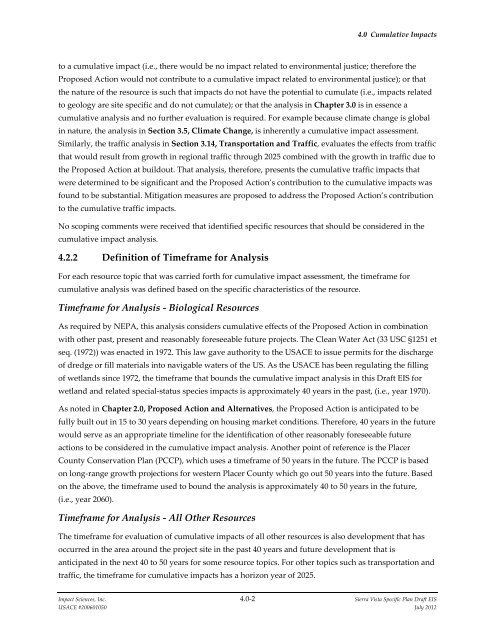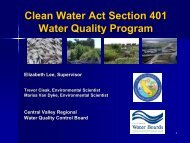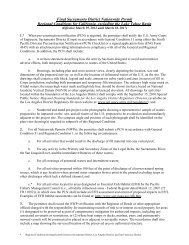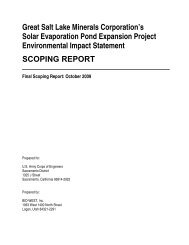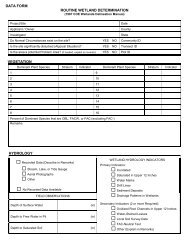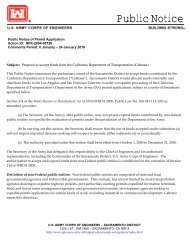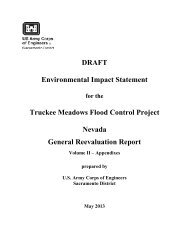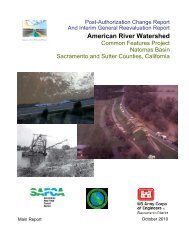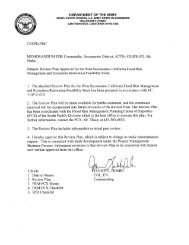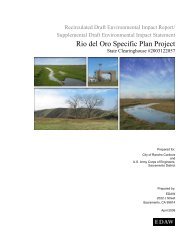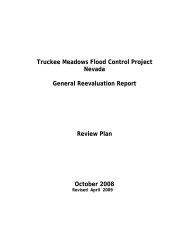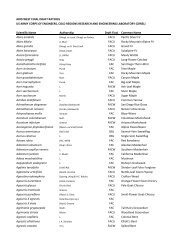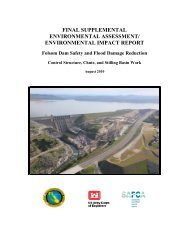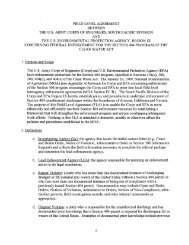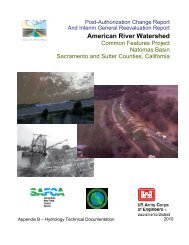4.0 CUMULATIVE IMPACTS - Sacramento District - U.S. Army
4.0 CUMULATIVE IMPACTS - Sacramento District - U.S. Army
4.0 CUMULATIVE IMPACTS - Sacramento District - U.S. Army
You also want an ePaper? Increase the reach of your titles
YUMPU automatically turns print PDFs into web optimized ePapers that Google loves.
<strong>4.0</strong> Cumulative Impacts<br />
to a cumulative impact (i.e., there would be no impact related to environmental justice; therefore the<br />
Proposed Action would not contribute to a cumulative impact related to environmental justice); or that<br />
the nature of the resource is such that impacts do not have the potential to cumulate (i.e., impacts related<br />
to geology are site specific and do not cumulate); or that the analysis in Chapter 3.0 is in essence a<br />
cumulative analysis and no further evaluation is required. For example because climate change is global<br />
in nature, the analysis in Section 3.5, Climate Change, is inherently a cumulative impact assessment.<br />
Similarly, the traffic analysis in Section 3.14, Transportation and Traffic, evaluates the effects from traffic<br />
that would result from growth in regional traffic through 2025 combined with the growth in traffic due to<br />
the Proposed Action at buildout. That analysis, therefore, presents the cumulative traffic impacts that<br />
were determined to be significant and the Proposed Action’s contribution to the cumulative impacts was<br />
found to be substantial. Mitigation measures are proposed to address the Proposed Action’s contribution<br />
to the cumulative traffic impacts.<br />
No scoping comments were received that identified specific resources that should be considered in the<br />
cumulative impact analysis.<br />
4.2.2 Definition of Timeframe for Analysis<br />
For each resource topic that was carried forth for cumulative impact assessment, the timeframe for<br />
cumulative analysis was defined based on the specific characteristics of the resource.<br />
Timeframe for Analysis - Biological Resources<br />
As required by NEPA, this analysis considers cumulative effects of the Proposed Action in combination<br />
with other past, present and reasonably foreseeable future projects. The Clean Water Act (33 USC §1251 et<br />
seq. (1972)) was enacted in 1972. This law gave authority to the USACE to issue permits for the discharge<br />
of dredge or fill materials into navigable waters of the US. As the USACE has been regulating the filling<br />
of wetlands since 1972, the timeframe that bounds the cumulative impact analysis in this Draft EIS for<br />
wetland and related special-status species impacts is approximately 40 years in the past, (i.e., year 1970).<br />
As noted in Chapter 2.0, Proposed Action and Alternatives, the Proposed Action is anticipated to be<br />
fully built out in 15 to 30 years depending on housing market conditions. Therefore, 40 years in the future<br />
would serve as an appropriate timeline for the identification of other reasonably foreseeable future<br />
actions to be considered in the cumulative impact analysis. Another point of reference is the Placer<br />
County Conservation Plan (PCCP), which uses a timeframe of 50 years in the future. The PCCP is based<br />
on long-range growth projections for western Placer County which go out 50 years into the future. Based<br />
on the above, the timeframe used to bound the analysis is approximately 40 to 50 years in the future,<br />
(i.e., year 2060).<br />
Timeframe for Analysis - All Other Resources<br />
The timeframe for evaluation of cumulative impacts of all other resources is also development that has<br />
occurred in the area around the project site in the past 40 years and future development that is<br />
anticipated in the next 40 to 50 years for some resource topics. For other topics such as transportation and<br />
traffic, the timeframe for cumulative impacts has a horizon year of 2025.<br />
Impact Sciences, Inc. <strong>4.0</strong>-2 Sierra Vista Specific Plan Draft EIS<br />
USACE #200601050 July 2012


